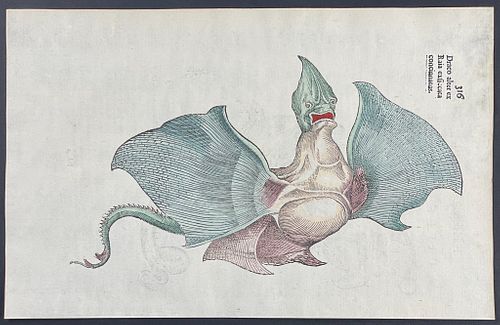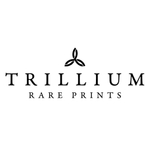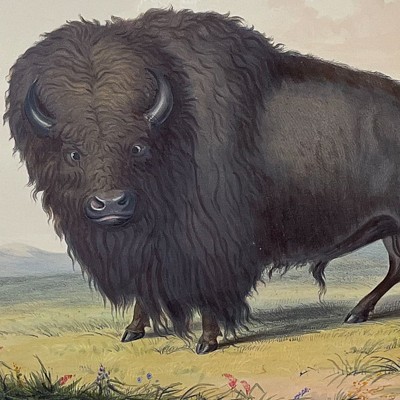Aldrovandi, pub. 1640 - Dragon or Monster. 316
About Seller
115 Hampsted Lane
Franklin, TN 37069
United States
Trillium Antique Prints & Rare Books is a family run business with over 25 years experience in the field. The Baggetts have specialized in selling antique prints and books related to natural history, travel, fashion, architecture, and more from the 17th to early 20th century. We look to offer a uniq...Read more
Two ways to bid:
- Leave a max absentee bid and the platform will bid on your behalf up to your maximum bid during the live auction.
- Bid live during the auction and your bids will be submitted real-time to the auctioneer.
Bid Increments
| Price | Bid Increment |
|---|---|
| $0 | $5 |
| $100 | $10 |
| $300 | $25 |
| $700 | $50 |
About Auction
Nov 26, 2022
Trillium Antique Prints & Rare Books sales@trilliumrareprints.com
- Lot Description
This extraordinarily rare, first edition, folio engraving is from Ulysse Aldrovandi’s Opera Omnia. The work was published between 1599 and 1648 in Bologna, Italy by Clemente Ferroni, Niccolo Tebaldini, & Giovanni Battista Bellagamba. Many of the illustrations are the work of Jacopo Ligozzi. It was a massive, multi-volume, natural history encyclopedia.
This work included the first published image of a toucan and bird of paradise. It was originally 13 volumes in total and featured illustrations of animals, plants, minerals, and fantastic “monsters” including dragons.
Aldrovandi was an Italian botanist, pharmacologist, and noted author. He studied mathematics, Latin, law, and philosophy eventully earning a degree in medicine in 1553. In 1549, on return from studies in Paua, he was arrested in Bologna for heresy and sent to Rome where he managed to exonerate himself, likely due to his parents' nobility.
Aldrovandi channeled much of his life’s work into collecting, writing and illustrating different biological specimens. His collection is now in display in the University in Bologna. The specimens were classified according to his own system and contributed to the later development of animal taxonomy.
He became a full professor at the University of Bologna in 1561 where he presented natural history as a systematic study. He was also appointed the inspector of drugs and pharmacies, which met opposition, but was confirmed by Pope Gregory XIII. The Pope actually became a benefactor of Aldrovandi's numerous works on natural history.
Only four of the volumes credited to Aldrovandi appeared in his life time (1522-1605). His students used his manuscripts to complete the remainder of his work. It was the largest collection of natural history illustrations to appear before the 18th century.
“Aldrovandi was aware that the enormity of his task would stretch beyond his lifetime; just as Aristotle had passed his work on to his disciples, Aldrovandi hoped that his own pupils would continue the unfinished business of writing the definitive history of nature. At the end of his life, his literary production -mostly based on the objects of his museum- totaled more than 400 volumes, a number that he claimed would take more than a century to print. ‘And with all this I have kept three scribes in my house, excellent painters, designers, engravers, and have spent much on transportation [of artifacts] and on a library that can stand up to any other particular library in Italy.’ While it is hardly surprising that we should find Aldrovandi's attempts to bring all knowledge under one roof overwhelming, given our own assumption that there is always more to know, the number and size of his many unfinished projects amazed even contemporaries…
“Separate from the thirteen printed volumes, which covered a range of topics -birds, insects, fish, quadrupeds, serpents, monsters, and hard objects, that is, stones, metals, gems, and fossils- the manuscripts included Aldrovandi 's voluminous correspondence, drafts of treatises, tables that classified and tabulated the natural world, and his own encyclopedic compendia that organized all his reading notes alphabetically, topically, and geographically.” (Findlen, Possessing Nature)
The scope and titles of the volumes ae as follows:
Vols. I-III. The Ornithology: Ornithologiae, hoc est, De Avibus Historiae Libri...
Vol. IV. Fishes & Whales: De Piscibus Libri V et De Cetibus Lib. Unus.
Vol. V. Monsters: Monstrorum historia cum Paralipomenis historiae omnium animalium
Vol. VI. From Dogs to Chameleons: The “Clawed” Quadrupeds: De Quadrupedib. Digitatis Viviparis Libri Tres, et De Quadrupedibus Digitatis Oviparis Libri Duo. Bartholomaeus Ambrosinus… collegit
Vol. VII. Cloven-hoofed Quadrupeds: Quadrupedum omnium bisulcorum historia
Vol. VIII. Solid-hoofed Quadrupeds: De Quadrupedibus solidipedibus volumen integrum, Joannes Cornelius Uterverius, collegit et recensuit. Hyeronimus Tamburinus in lucem edidit
Vol. IX. Marine Invertebrates: De Reliquis Animalibus Exanguibus Libri Quatuor, nempe de Mollibus, Crustaceis, Testaceis, et Zoophytis
Vol. X. Snakes & Dragons: Serpentum, et Draconum Historiae Libri Duo
Vol. XI. The Botanical Collection: Dendrologiae naturalis scilicet arborum historiae libri duo sylua glandaria, acinosumque pomarium vbi eruditiones omnium generum unà cum botanicis doctrinis ingenia quaecunque non parum iuvant, et oblectant Ovidius Montalbanus
Vol. XII. Insects: De animalibus insectis libri septem
Vol. XIII. Metals & Minerals, including Fossils: Musaeum MetallicumThe work is in good to very good condition overall. There may be some light imperfections or fox marks on the paper. There can be some text of image bleed through or offset with this work. Old library inked stamps have been carefully removed to some engravings from the work. Please review the image carefully for condition and contact us with any questions.Condition
Paper Size: ~ 9" by 14" - Shipping Info
-
Shipping is handled within 1 business days of completed payment. If you have specific shipping requests or address changes, please contact us before completing payment so we are aware and can adjust the invoice if necessary. Shipping is billed directly after the sale. We typically ship via USPS and FedEx domestic and with USPS and DHL international. We calculate based on the total package weight and destination. All shipments are insured, though to provide this some services may be required when shipping outside of the United States. We're glad to provide quotes and options of services. The buyer is responsible for paying the customs fees, duties, import taxes, and any related charges. Customs can cause delays in arrival of your shipment, which the seller has no control over. Please consider these charges and delays when making your purchase. If you need specific wording for customs, please also contact before payment as each country has different rules and we will try to accommodate when possible.
-
- Payment & Auction Policies
-
Available payment options
Invoicing and payment are completed through Bidsquare's system. If an alternate form of payment is requested, please contact us. Payment for winning lots should be completed within 10 business days. We are also glad to answer any additional questions on condition or service. We typically answer very quickly, but always within one business day. All purchases are guaranteed to be authentic. These are all antique items and thus may exhibit imperfections from time and wear, please contact with any concerns before the auction. While we do request you put a credit card on file to bid, we do not require this and may not automatically charge you for the lots, though we do reserve this right.
-
-
- Buyer's Premium



 EUR
EUR CAD
CAD AUD
AUD GBP
GBP MXN
MXN HKD
HKD CNY
CNY MYR
MYR SEK
SEK SGD
SGD CHF
CHF THB
THB



















